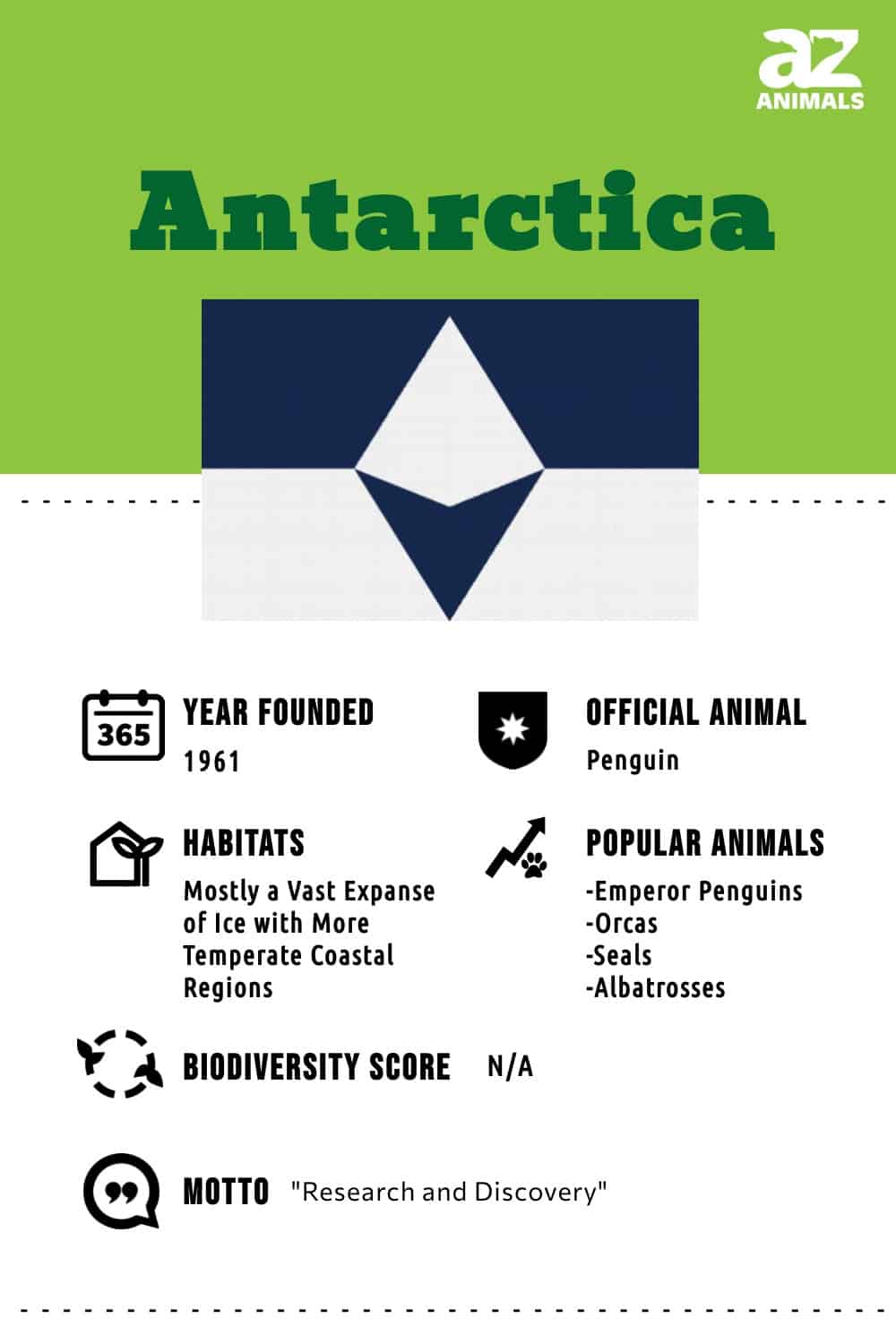
Below you can find a complete list of Antarctican animals. We currently track 35 animals in Antarctica and are adding more every day!
Antarctica is a frigid polar continent located at the bottom of the world. Its nearest continental neighbors are Australia and South America, but these lands have little in common with Antarctica in terms of habitat and biodiversity.
Because of its limited rainfall, Antarctica is considered a frozen desert. Most of its wildlife are extremophiles – rare organisms well-adapted to live in environments in which most of Earth’s creatures would find it difficult to survive. Among the most recognizable of Antarctica’s wildlife are penguins, leopard seals, and killer whales.
Even more diverse animals live on the Antarctic Peninsula and the surrounding islands, which have a milder climate than Antarctica itself. Keep reading to learn facts about the wild and wonderful animals that call Antarctica home.
The Official National Animal of Antarctica
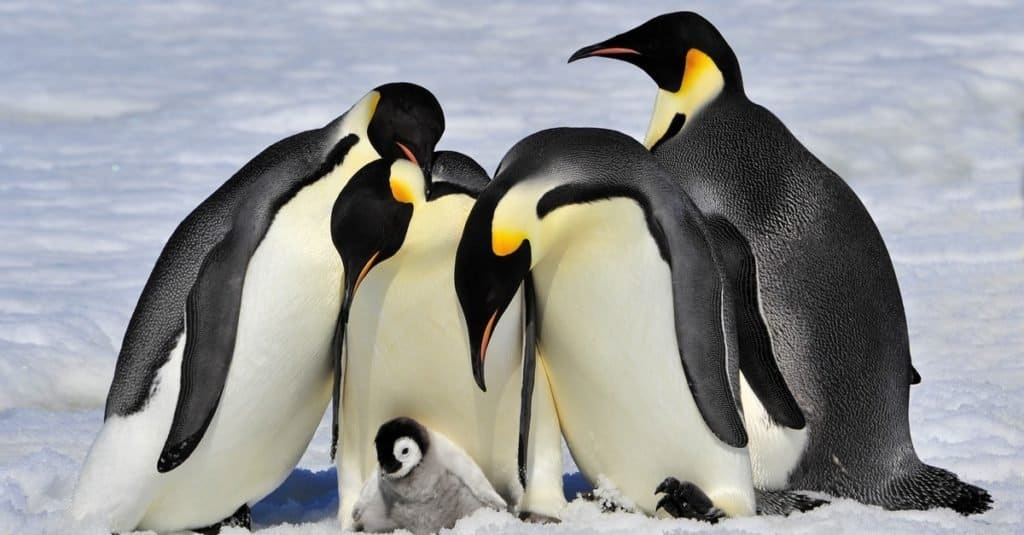
Male Emperor Penguins take care of the baby chicks while the females hunt for food.
©vladsilver/Shutterstock.com
The penguin is the national symbol of Antarctica. Eight species of penguins live in Antarctica, and no one is designated as the national animal. Rather, the penguin family as a whole symbolizes this rugged continent.
These incredible birds achieve astonishing feats every day to achieve a stable life in the frozen tundra they call home. Some species have been known to walk up to 60 miles across ice sheets to reach their breeding grounds. Penguins can hold their breath longer than any other birds (up to 27 minutes!) They use this skill to dive to depths of as low as 1,640 feet to catch food in the frigid waters off the Antarctic coast.
Where To Find The Top Wild Animals in Antarctica
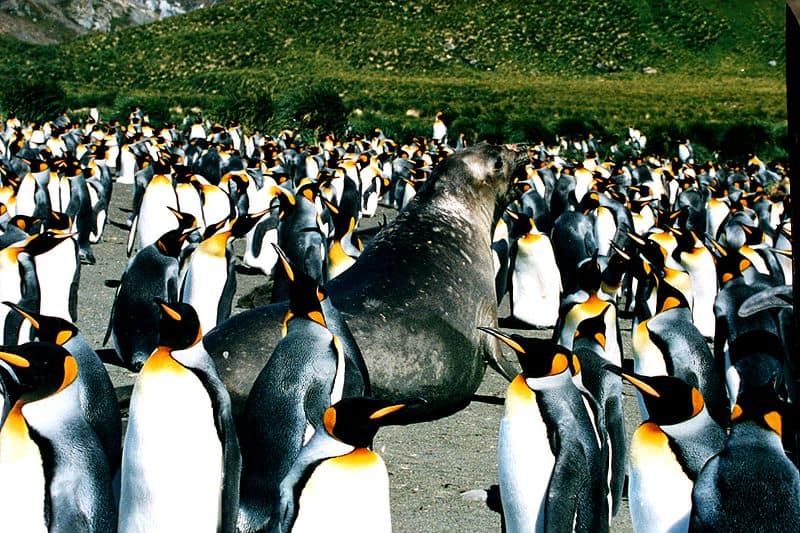
Elephant
Seals and King Penguins congregate on the temperate coast of South Georgia Island.
Antarctica’s animals are mostly found along the coast, where the extreme temperatures of the ice sheets closer to the South Pole are not as harsh. There are many islands north of Antarctica where local wildlife may migrate to during the winter, other creatures like penguins choose to tough out the cold season by huddling together for warmth.
The Most Dangerous Animals In Antarctica Today
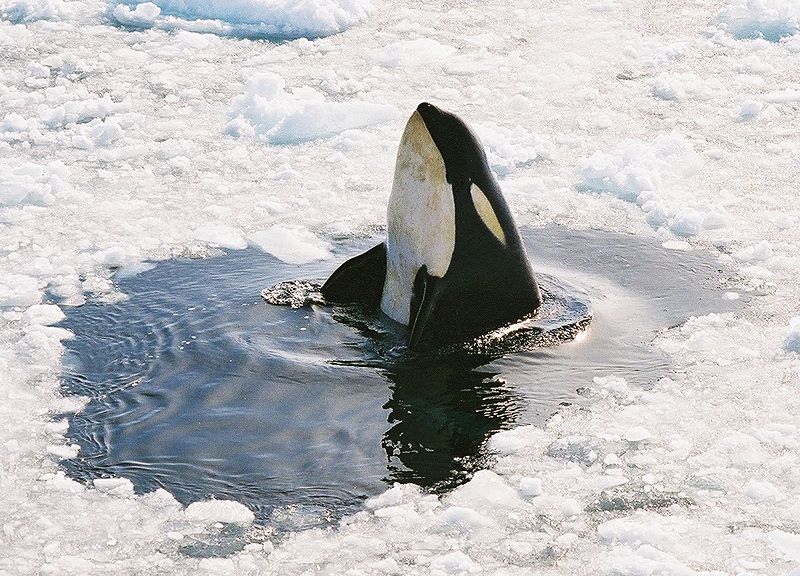
Orcas are some of the deadliest animals in Antarctica.
©Jaime Ramos – Public Domain by National Science Foundation
Leopard seals and orcas are the most dangerous animals to inhabit Antarctica. Pods of orcas can take on prey as large as great white sharks and blue whales. It is rare a rare occurrence but they have occasionally attacked small boats.
Leopard seals have been known to strike out at or bite photographers, sightseers, or divers who got too close. As with orcas, this is rare and leopard seals are not normally dangerous to humans – so long as we keep a respectful distance.
Elephant seals are another large Antarctic predator possessed of incredible power. Though they move too slowly on land to typically threaten humans, these creatures are a menace to local fish, squids, sharks and rays.
Antarctica’s Largest Animals
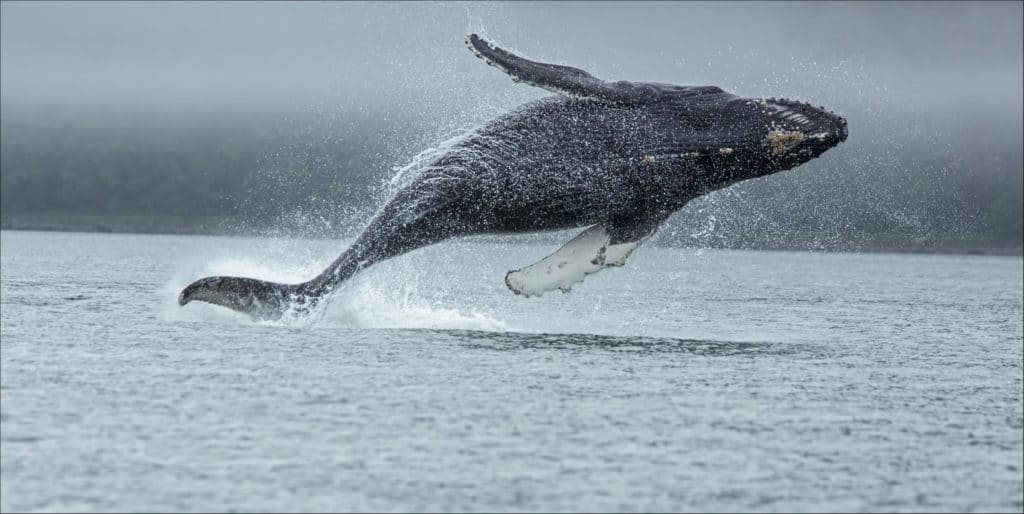
Blue Whale’s tongues are the size of an African Elephant!
©Danny Sullivan/Shutterstock.com
The Blue Whale is the largest animal in Antarctica, as well as the world. Blue Whales from around the frozen continent have fetched sizes larger than any others, reaching up to 330,000 lbs and 110 feet! These giants of the sea also live incredibly long lives, some reports estimating they can expect to live up to 200 years old.
Endangered Animals
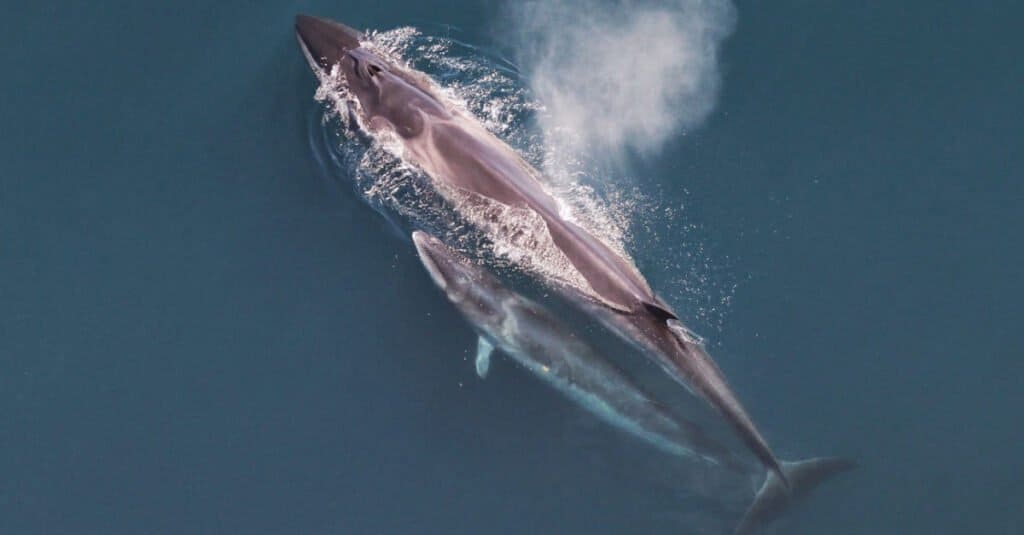
Sei Whale populations are in at the mercy of climate change and human interference.
©Christin Khan, NOAA / NEFSC, Public domain, via Wikimedia Commons – License
Half of the world’s penguin species are endangered of becoming extinct, including the iconic emperor penguin. Many albatross species and a bird called Abbott’s booby are also endangered. The Amsterdam albatross and Tristan albatross are considered critically endangered of becoming extinct.
Among the cetaceans, the sei whale, blue whale, and fin whale are endangered of becoming extinct.
What causes Antarctica’s animals to be endangered? Pollution, climate change, and overfishing are the biggest risk factors. Rats also prey on the eggs of many seabirds. Because Antarctica was separated from the rest of the world for so long, its ecosystems are especially susceptible to the changes brought about by humans.
What is the Rarest Animal in Antarctica?
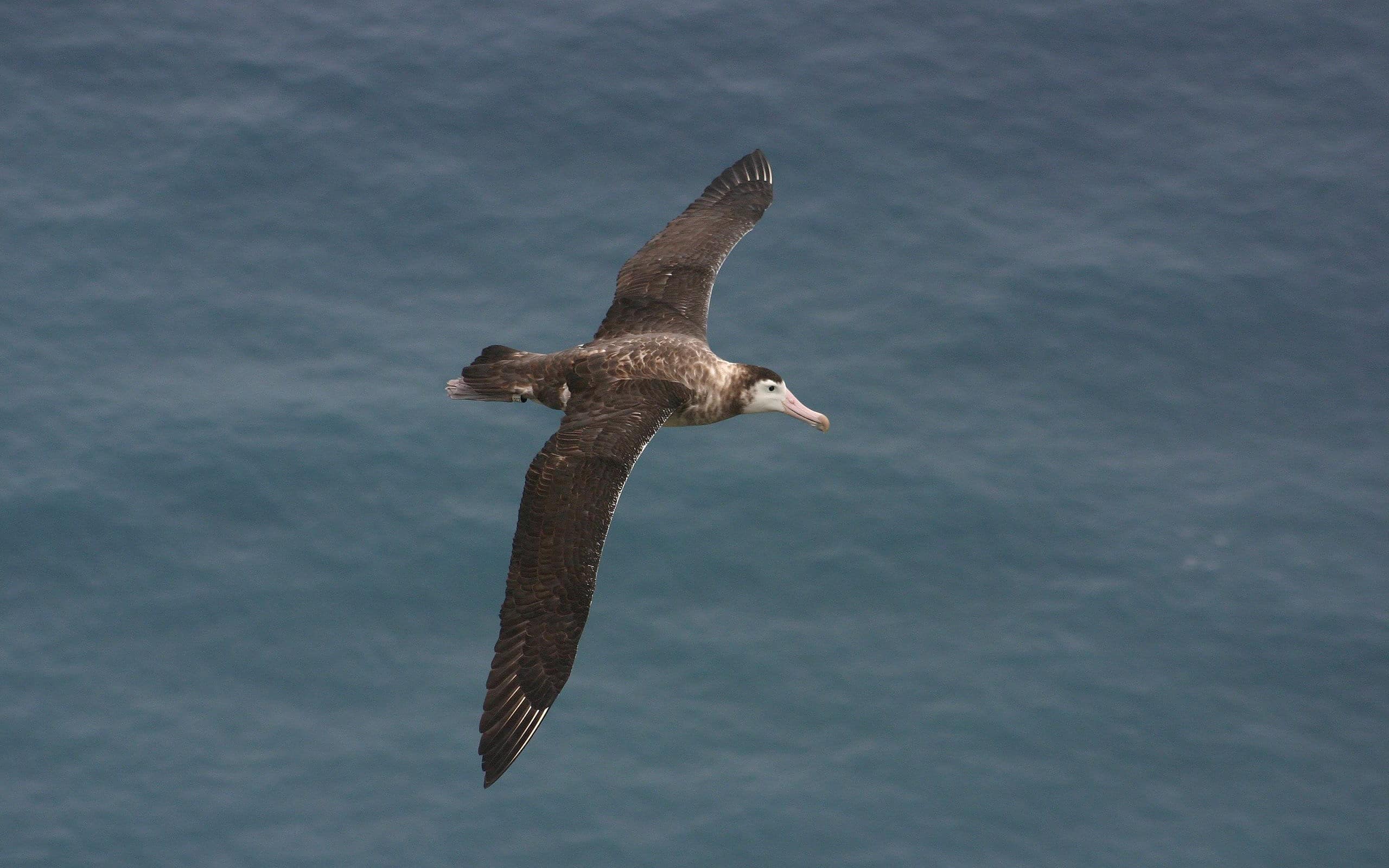
Amsterdam Albatrosses are endimic to Amsterdam Island.
©Vincent Legendre, CC BY-SA 3.0, via Wikimedia Commons – License
Antarctica’s rarest animal is the Amsterdam Albatross. This seabird can only be found on Amsterdam Island in the Southern Indian Ocean above Antarctica. Here the drainage of a local peat bog used for breeding by the albatross, in addition to longline fishing and a growing population of cats, cattle and ship rats has caused the lone population of these rare birds to dwindle down to some 92 individuals.
Antarctican Animals
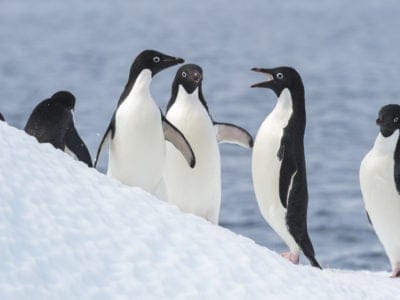
Adélie Penguin
Eats up to 2kg of food per day!
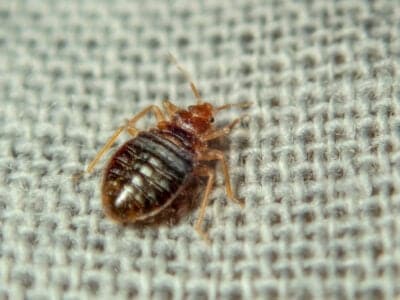
Bed Bugs
Bed bugs feed for 4-12 minutes.
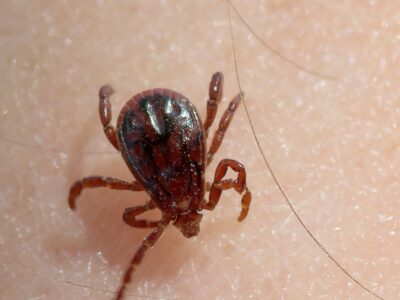
Brown Dog Tick
Can live its entire life indoors
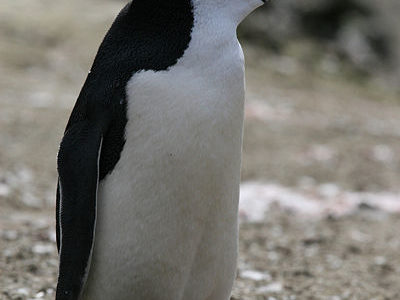
Chinstrap Penguin
There are 7 million breeding pairs!
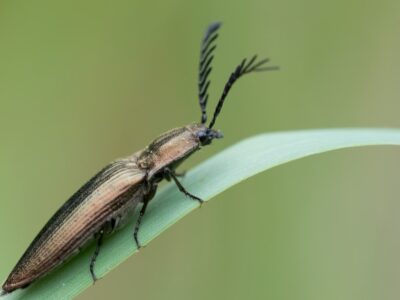
Click Beetle
Click beetles are named for the clicking noise they make to escape predators.
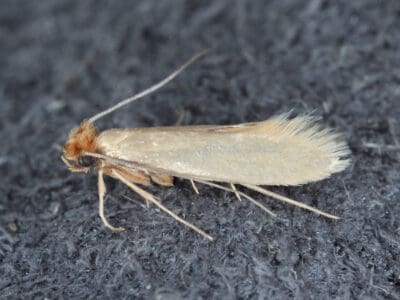
Clothes Moth
Clothes Moths can remain in the larvae stage for up to 2 years, but adults only live 10 days.
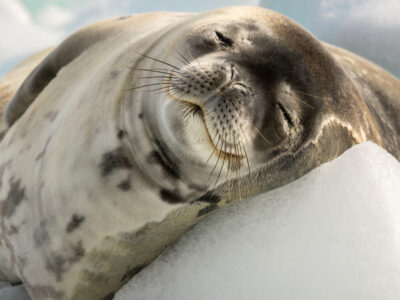
Crabeater Seal
The crabeater seal doesn’t actually eat crab at all, but instead krill
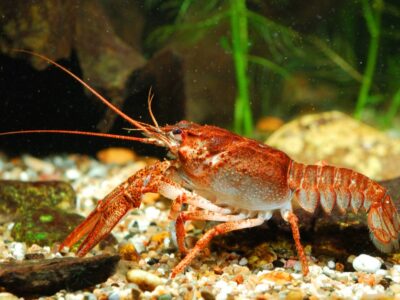
Crayfish
Female crayfish aren't that maternal; they have to secrete a form of pheromone, referred to as maternal pheromones, that encourages them to take care of their offspring and prevents them from eating their young.
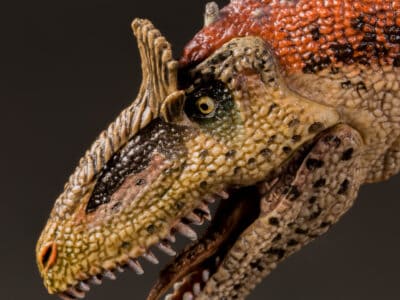
Cryolophosaurus
This dinosaur was known as the elvissaur due to its pompadour-like crest.
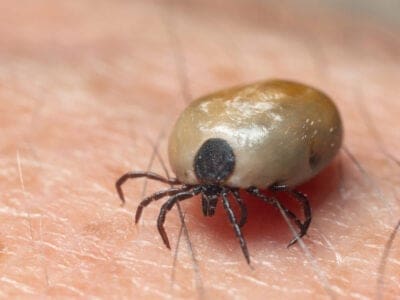
Dog Tick
Dog ticks feed on dogs and other mammals
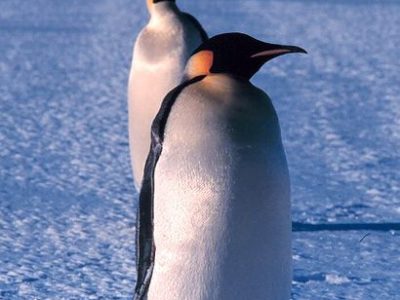
Emperor Penguin
The world's largest species of penguin!
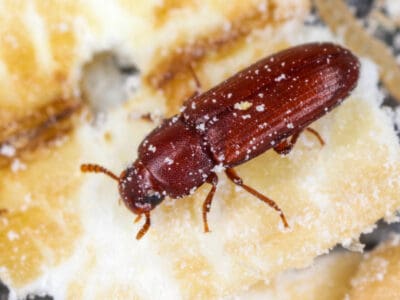
Flour Beetle
Flour beetles are adapted to survive in very dry environments.
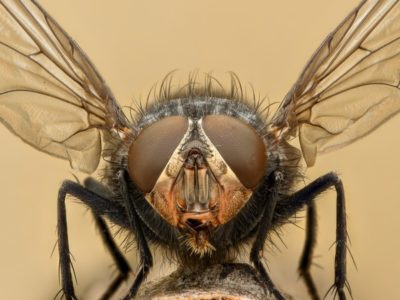
Fly
There are more than 240,000 different species!
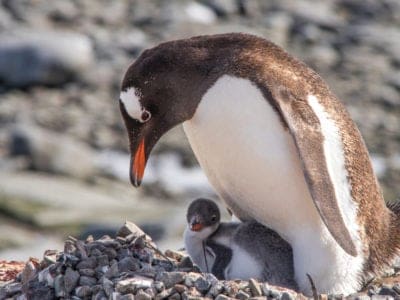
Gentoo Penguin
Found throughout the sub-Antarctic!
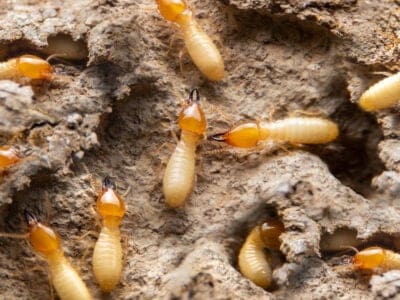
Insect
Insects go back over 350 million years, making the creatures older than man, flowering plants and dinosaurs.
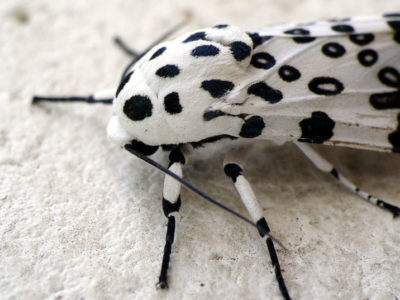
Insects
There are an estimated 30 million species!
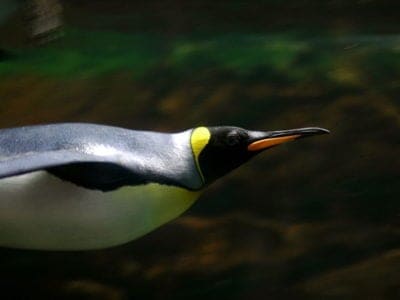
King Penguin
More than 2 million breeding pairs!
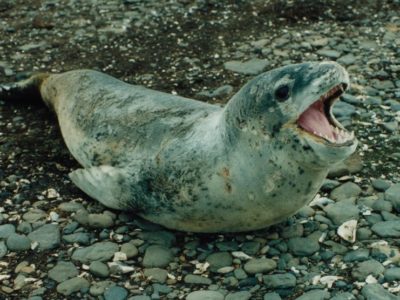
Leopard Seal
The world's most aggressive seal species!
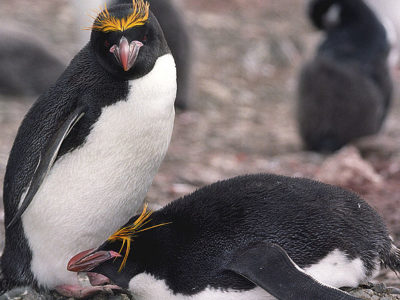
Macaroni Penguin
Gather in colonies of up to 100,000 members!
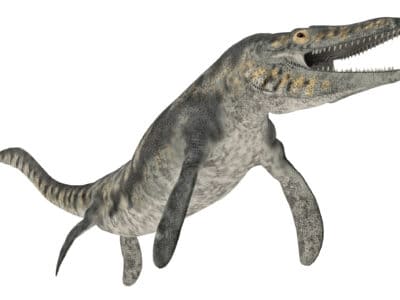
Mosasaurus
The Mosasaurus was much longer than the fearsome Tyrannosaur rex.
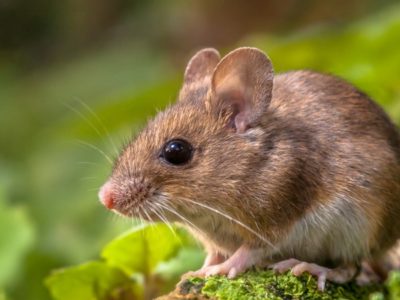
Mouse
Found on every continent on Earth!
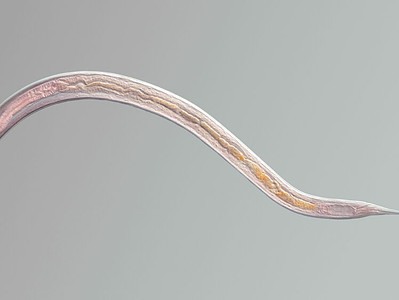
Nematode
Nematodes range in size from 1/10 of an inch to 28 feet long
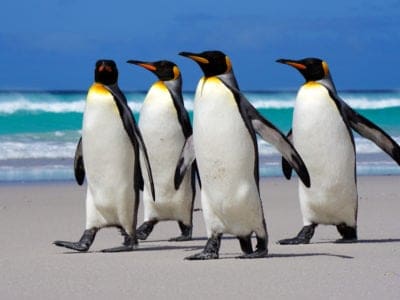
Penguin
Spends 75% of it's time hunting for food!
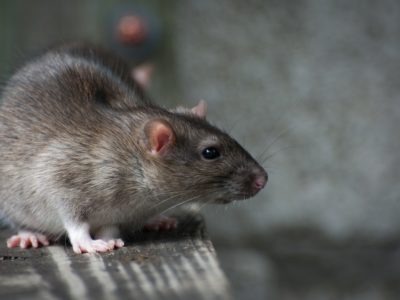
Rat
Omnivores that eat anything!
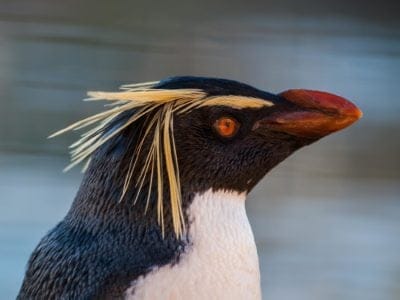
Rockhopper Penguin
There are 3 different species!
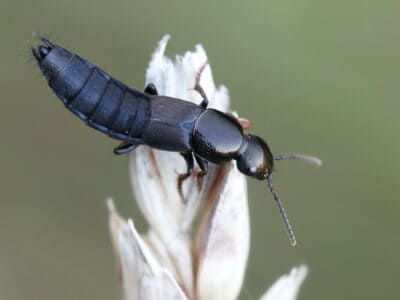
Rove Beetle
When threatened, rove beetles raise the ends of their body like scorpions, but they have no sting.
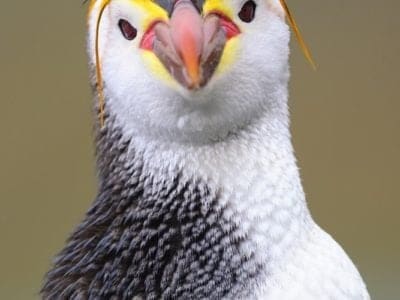
Royal Penguin
Can reach speeds of 20mph!
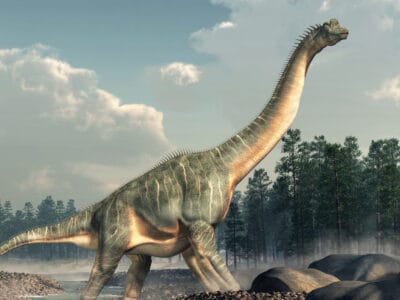
Sauropoda
Newly hatched sauropods weighted less than 11 pounds and put on 2 tons of weight a year!
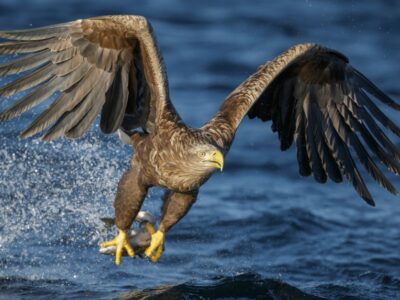
Sea Eagle
The sea eagle tends to mate for life with a single partner
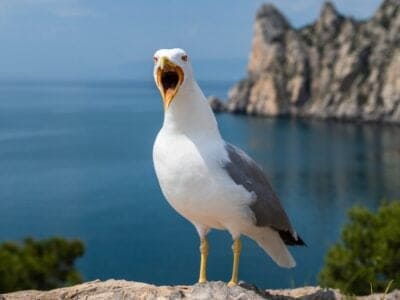
Seagull
Some gulls are capable of using tools
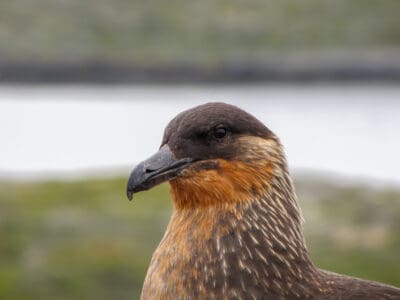
Skua
Skuas will chase other birds until they give up their catch
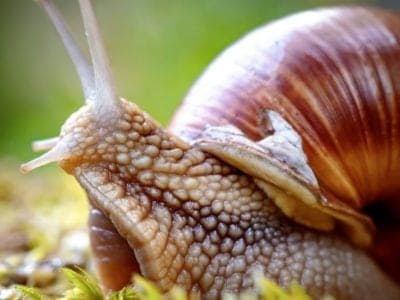
Snail
There are nearly 1,000 different species!
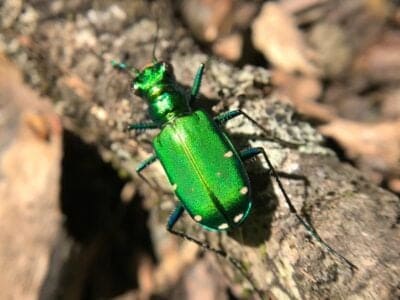
Tiger Beetle
The adult tiger beetle is one of the fastest land insects in the world
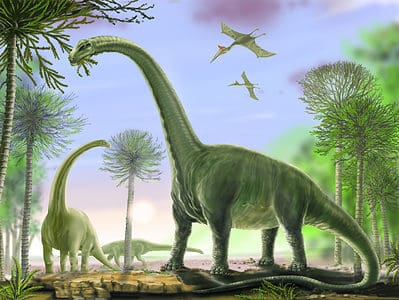
Titanosaur
Among the largest land animals to ever exist
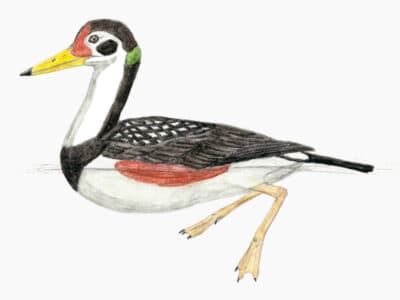
Vegavis
Vegavis was one of the earliest birds to have a sound-producing organ
Antarctican Animals List
- Adélie Penguin
- Bed Bugs
- Brown Dog Tick
- Chinstrap Penguin
- Click Beetle
- Clothes Moth
- Crabeater Seal
- Crayfish
- Cryolophosaurus
- Dog Tick
- Emperor Penguin
- Flour Beetle
- Fly
- Gentoo Penguin
- Insect
- Insects
- King Penguin
- Leopard Seal
- Macaroni Penguin
- Mosasaurus
- Mouse
- Nematode
- Penguin
- Rat
- Rockhopper Penguin
- Rove Beetle
- Royal Penguin
- Sauropoda
- Sea Eagle
- Seagull
- Skua
- Snail
- Tiger Beetle
- Titanosaur
- Vegavis
Animals in Antarctica FAQs (Frequently Asked Questions)
Where in the World is Antarctica?
Antarctica is a polar landmass located at the bottom of the globe. It contains the South Pole. Much of the land there – around 98 percent – is covered in a thick layer of ice and snow. Very few plants can grow there. The coldest temperature ever recorded on Earth was logged in Antarctica – negative 128.9 degrees Fahrenheit, or negative 89.4 degrees Celsius.
What Kinds of Animals Live in Antarctica?
Mammals, birds, fish, and invertebrates call Antarctica home.
The southern elephant seal, Antarctic fur seal, crabeater seal, Weddell seal, leopard seal, and Ross seal live in Antarctica, as do six types of baleen whales and four toothed whales.
Migratory seabirds can often be seen near the coast – albatross, skuas, petrels, gulls, terns, and ducks, among others – but penguins are Antarctica’s most famous avian inhabitants. In fact, the emperor penguin, the star of films like March of the Penguins and Happy Feet, is the only animal to have its young inland during the winter.
Antarctic krill, a tiny shrimp, is a keystone species, meaning it is an important basis of the food chain. In summer, vast swarms of krill fill the waters around Antarctica.
Fish common to the region include snailfish, eelpouts, hagfish, lamprey, shates, pearlfish, morid cod, eel cod, gadid cod, horsefish, Antarctic sculpins, triplefins, southern flounder, and cod icefish.
You’ll also find animals on the seafloor, deep below the ice. These include marine snails, worms, starfish, and sea cucumbers.
How Many Animals Live in Antarctica?
Compared to most of the rest of the world, Antarctica is home to few species – around 235 marine species. Facts show that there are eight species of penguins, seven species of seals, ten species of whales, and a few migratory birds and terrestrial invertebrates. Many types of fish and invertebrates, however, can be found in the waters surrounding Antarctica. About 320 species of fish have been described.
It is estimated that over 11 million individual penguins live in the Southern Hemisphere. A majority of these spend at least part of their lives in Antarctica. Over 100 million birds nest on Antarctica and its islands each spring. On the seafloor, there can be as many as 155,000 animals within one square meter (about 11 square feet).
Are There Wolves in Antarctica?
Wolves are not native to Antarctica. Sometimes a descendant of wolves – the domestic dog – can be found there, accompanying their human handlers. Sled dogs have been used for transportation in Antarctica.
Do Any Mammals Live in Antarctica?
Yes! Antarctica is home to some of the most fascinating wild mammals in the world. A number of seals live on the coast, and at least ten different types of whales swim through its waters.
Of course, humans – another mammal – also live there year-round in research stations. With them have come rodents, livestock, and other domestic animals.
Are There Any Land Animals in Antarctica?
There are no fully terrestrial native small to large animals – animals that live only on land – in Antarctica. Most animals, like seals and penguins, spend time on land but also rely on the ocean to survive.
Human activity, however, has introduced non-native land animals. Rats, mice, fish, and beetles can be found near human research stations. Humans also keep domestic animals such as chickens, rabbits, cats, dogs, pigs, sheep, cows, and reindeer.
There are also endemic insects and arthropods, including mites, springtails, nematodes, spiders, beetles, earthworms, and flies.



